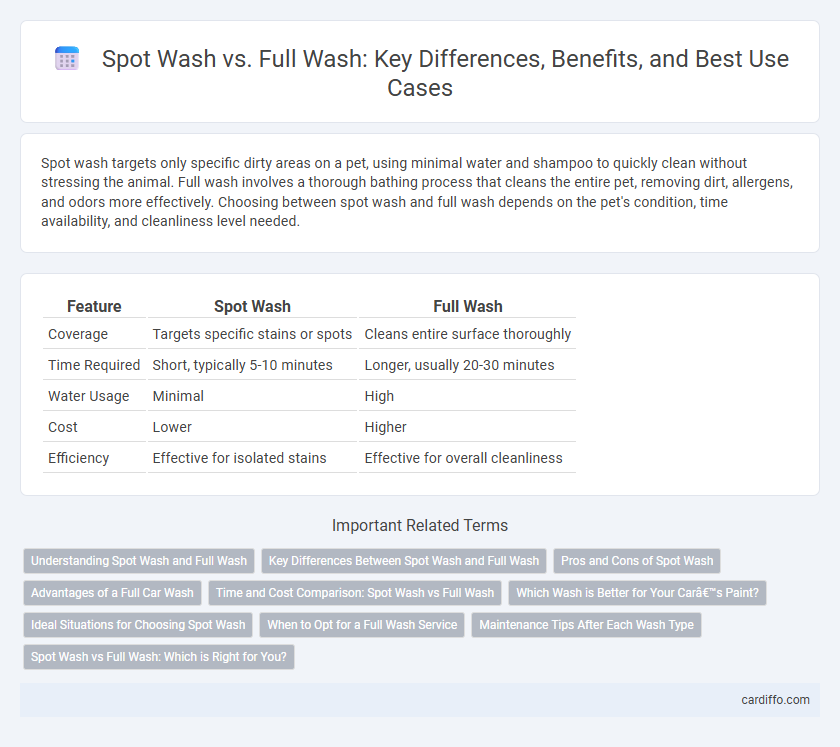Spot wash targets only specific dirty areas on a pet, using minimal water and shampoo to quickly clean without stressing the animal. Full wash involves a thorough bathing process that cleans the entire pet, removing dirt, allergens, and odors more effectively. Choosing between spot wash and full wash depends on the pet's condition, time availability, and cleanliness level needed.
Table of Comparison
| Feature | Spot Wash | Full Wash |
|---|---|---|
| Coverage | Targets specific stains or spots | Cleans entire surface thoroughly |
| Time Required | Short, typically 5-10 minutes | Longer, usually 20-30 minutes |
| Water Usage | Minimal | High |
| Cost | Lower | Higher |
| Efficiency | Effective for isolated stains | Effective for overall cleanliness |
Understanding Spot Wash and Full Wash
Spot wash targets specific areas of dirt or stains on fabric, using minimal water and detergent to preserve the overall garment. Full wash involves immersing the entire item in water and detergent, ensuring a thorough clean but consuming more resources. Choosing between spot wash and full wash depends on the garment's condition, with spot wash ideal for light soiling and full wash necessary for heavily soiled or overall dirty clothes.
Key Differences Between Spot Wash and Full Wash
Spot wash targets specific areas of dirt or stains on a surface, using minimal water and cleaning agents for quick, localized cleaning. Full wash involves cleaning the entire surface thoroughly, requiring more water, detergent, and time to remove all dirt, grime, and contaminants. The key differences lie in the scope, resource usage, and cleaning intensity, with spot wash being efficient for minor blemishes and full wash ensuring comprehensive cleanliness.
Pros and Cons of Spot Wash
Spot wash targets specific areas of dirt or stains on a vehicle, offering a quick and water-efficient cleaning method ideal for minor messes. It saves time and reduces water usage compared to a full wash, but it may leave the rest of the vehicle less clean and can risk uneven appearance if done improperly. Spot wash is best suited for maintaining cleanliness between full washes but is not a substitute for comprehensive vehicle maintenance.
Advantages of a Full Car Wash
A full car wash thoroughly removes dirt, grime, and salt from all vehicle surfaces, including hard-to-reach areas like wheel wells and undercarriage, preventing rust and paint damage. It restores the car's appearance by eliminating contaminants that spot washes might miss, providing a deeper clean that extends the life of the paint and protective coatings. Regular full washes also improve vehicle resale value by maintaining a pristine exterior and reducing long-term maintenance costs.
Time and Cost Comparison: Spot Wash vs Full Wash
Spot wash requires significantly less time than a full wash, often taking just 5 to 10 minutes compared to 30 to 60 minutes for a complete wash. Cost-wise, spot washes are generally more affordable, with prices typically ranging between $10 to $25, whereas full washes can cost $30 to $70 or more depending on vehicle size and service level. Choosing spot wash saves both time and money when only minor cleaning is needed, while full wash offers comprehensive care that justifies the higher expense and duration.
Which Wash is Better for Your Car’s Paint?
Spot wash targets specific dirty areas using minimal water and pressure, reducing the risk of paint damage caused by excessive scrubbing. Full wash covers the entire vehicle, removing all contaminants that can lead to paint deterioration but may expose the car to potential abrasion if not done properly. Choosing the right wash depends on the level of dirt and paint condition; spot wash preserves delicate finishes while full wash offers thorough protection against widespread grime.
Ideal Situations for Choosing Spot Wash
Spot wash is ideal for removing specific stains or localized dirt on clothing without the need for a full wash cycle. This method is especially useful for delicate fabrics or garments that do not require frequent overall cleaning. Spot washing conserves water, reduces wear on fabrics, and saves time compared to a full wash.
When to Opt for a Full Wash Service
A full wash service is essential when your vehicle has accumulated heavy dirt, grime, or mud that spot washing cannot effectively remove. After long road trips, exposure to harsh weather conditions, or seasonal pollen buildup, a comprehensive full wash ensures thorough cleaning and protection of the paintwork and undercarriage. Opting for a full wash regularly helps maintain the car's resale value and prevents corrosion caused by prolonged contamination.
Maintenance Tips After Each Wash Type
Spot wash effectively removes localized dirt and stains, preserving the car's clear coat by reducing the need for full washes that can cause wear over time. After spot washing, promptly dry the surface to prevent water spots and apply a quick detailer spray to maintain shine and protection. Following a full wash, use a microfiber towel for drying, inspect for missed dirt, and apply wax or sealant to prolong the paint's durability and enhance longevity.
Spot Wash vs Full Wash: Which is Right for You?
Spot wash targets specific stains or dirt, using less water and detergent, making it ideal for quick touch-ups and sensitive fabrics. Full wash involves cleaning the entire garment thoroughly, removing all dirt and odors but requiring more time, water, and energy. Choosing between spot wash and full wash depends on the garment's condition, fabric type, and environmental considerations.
Spot Wash vs Full Wash Infographic

 cardiffo.com
cardiffo.com